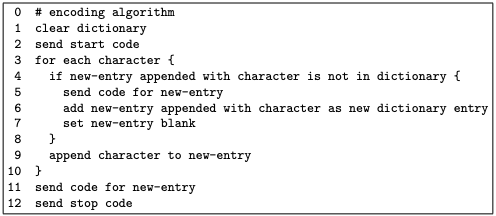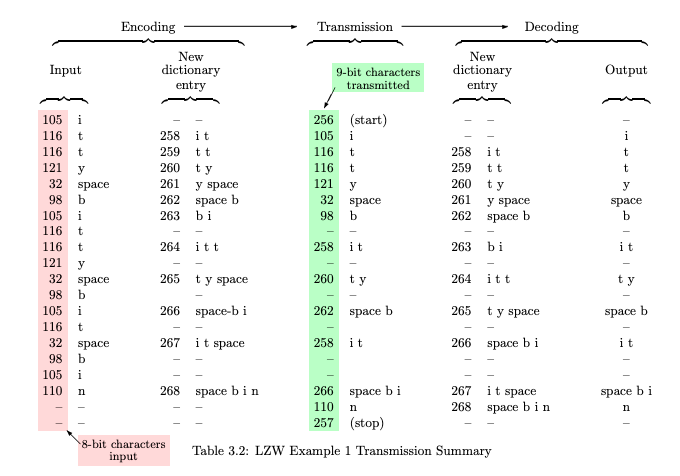3.7.1: LZW Algorithm, Example 1
- Page ID
- 50919
Consider the encoding and decoding of the text message
itty bitty bit bin
(this peculiar phrase was designed to have repeated strings so that the dictionary builds up rapidly).
The initial set of dictionary entries is 8-bit character code with code points 0–255, with ASCII as the first 128 characters, including the ones in Table 3.1 which appear in the string above. Dictionary entry 256 is defined as “clear dictionary” or “start,” and 257 as “end of transmission” or “stop.” The encoded message is a sequence of numbers, the codes representing dictionary entries. Initially most dictionary entries consist of a single character, but as the message is analyzed new entries are defined that stand for strings of two or more characters. The result is summarized in Table 3.2.
| 32 | space | 116 | t |
| 98 | b | 121 | y |
| 105 | i | 256 | start |
| 110 | n | 257 | stop |
Encoding algorithm: Define a place to keep new dictionary entries while they are being constructed and call it new-entry. Start with new-entry empty, and send the start code. Then append to the new-entry the characters, one by one, from the string being compressed. As soon as new-entry fails to match any existing dictionary entry, put new-entry into the dictionary, using the next available code point, and send the code for the string without the last character (this entry is already in the dictionary). Then use the last character received as the first character of the next new-entry. When the input string ends, send the code for whatever is in new-entry followed by the stop code. That’s all there is to it.
For the benefit of those who appreciate seeing algorithms written like a computer program, this encoding algorithm is shown in Figure 3.5. When this procedure is applied to the string in question, the first character


is “i” and the string consisting of just that character is already in the dictionary. So the next character is appended to new-entry, and the result is “it” which is not in the dictionary. Therefore the string which was in the dictionary, “i,” is sent and the string “i t” is added to the dictionary, at the next available position, which is 258. The new-entry is reset to be just the last character, which was not sent, so it is “t”. The next character “t” is appended and the result is “tt” which is not in the dictionary. The process repeats until the end of the string is reached.
For a while at the beginning the additional dictionary entries are all two-character strings, and there is a string transmitted for every new character encountered. However, the first time one of those two-character strings is repeated, its code gets sent (using fewer bits than would be required for two characters sent separately) and a new three-character dictionary entry is defined. In this example it happens with the string “i t t” (this message was designed to make this happen earlier than would be expected with normal text). Later in this example, the code for a three-character string gets transmitted, and a four-character dictionary entry defined.
In this example the codes are sent to a receiver which is expected to decode the message and produce as output the original string. The receiver does not have access to the encoder’s dictionary and therefore the decoder must build up its own copy.
Decoding algorithm: If the start code is received, clear the dictionary and set new-entry empty. For the next received code, output the character represented by the code and also place it in new-entry. Then for subsequent codes received, append the first character of the string represented by the code to new-entry, insert the result in the dictionary, then output the string for the received code and also place it in new-entry to start the next dictionary entry. When the stop code is received, nothing needs to be done; new-entry can be abandoned.
This algorithm is shown in program format in Figure 3.6.

Note that the coder and decoder each create the dictionary on the fly; the dictionary therefore does not have to be explicitly transmitted, and the coder deals with the text in a single pass.
Does this work, i.e., is the number of bits needed for transmission reduced? We sent 18 8-bit characters (144 bits) in 14 9-bit transmissions (126 bits), a savings of 12.5%, for this very short example. For typical text there is not much reduction for strings under 500 bytes. Larger text files are often compressed by a factor of 2, and drawings even more.


